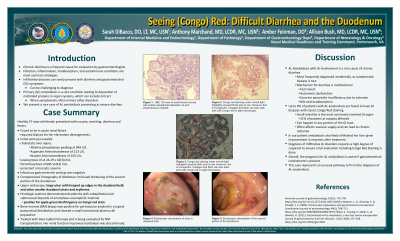Tuesday Poster Session
Category: Small Intestine
P4166 - Seeing (Congo) Red: Difficult Diarrhea and the Duodenum
Tuesday, October 24, 2023
10:30 AM - 4:00 PM PT
Location: Exhibit Hall

Has Audio

Sarah DiBacco, DO
Naval Medical Center
Portsmouth, VA
Presenting Author(s)
Sarah DiBacco, DO, Anthony Marchand, MD, Amber Feinman, DO, Allison Bush, MD
Naval Medical Center, Portsmouth, VA
Introduction: Chronic diarrhea is evaluated frequently by gastroenterologists with infection inflammation, malabsorption, and autoimmune conditions as the most common etiologies. Rarely, infiltrative diseases can present with diarrhea and gastrointestinal (GI) symptoms and can be challenging to diagnose. Primary (AL) amyloidosis is a rare condition leading to deposition of misfolded proteins in organ systems. This can include to GI tract, though when symptomatic often mimics other, more common disorders. We present a rare case of AL amyloidosis presenting as severe diarrhea.
Case Description/Methods: An otherwise healthy 57-year-old female presented with nausea, vomiting, diarrhea and fevers. She was found to be in acute renal failure and underwent dialysis for her electrolyte derangements. Her workup revealed a cholestatic liver injury, with alkaline phosphatase peaking at 949 U/L, Aspartate Aminotransferase of 213 U/L Alanine Aminotransferase of 250 U/L. She had a leukocytosis of at 24.29 x 10(3)/mcL, thrombocytosis of 685 x10(3) mcL, and a persistent microcytic anemia. Labs for infectious gastroenteritis were negative. Computerized Tomography of the abdomen revealed mild wall thickening of the second portion of the duodenum. Upper endoscopy showed a large ulcer with heaped up edges in the second portion of the duodenum and other smaller duodenal ulcers and erythema. Histologic sections of biopsies demonstrated duodenitis with subepithelial and submucosal deposits of amorphous eosinophilic material, which were positive for apple-green birefringence on Congo red stain. Bone marrow (BM) biopsy was positive for perivascular amyloid in a typical paracortical distribution and showed a small monoclonal plasma cell population. She was treated with Dara-CyBorD therapy and is being evaluated for BM transplantation. Her renal function improved and dialysis was discontinued.
Discussion: AL Amyloidosis with GI involvement is a rare cause of chronic diarrhea. Up to 8% of patients with AL amyloidosis are found to have GI biopsies with classic Congo Red staining and the small intestine is the most commonly involved GI organ. In our patient amyloidosis also likely infiltrated her liver given improvement in enzymes after treatment, which can result in a poorer prognosis. Consideration of infiltrative GI disorders requires a high degree of suspicion to ensure a full evaluation including Congo Red Staining is done. This case represents an unusual pathway to first-time diagnosis of AL amyloidosis.
Disclosures:
Sarah DiBacco, DO, Anthony Marchand, MD, Amber Feinman, DO, Allison Bush, MD. P4166 - Seeing (Congo) Red: Difficult Diarrhea and the Duodenum, ACG 2023 Annual Scientific Meeting Abstracts. Vancouver, BC, Canada: American College of Gastroenterology.
Naval Medical Center, Portsmouth, VA
Introduction: Chronic diarrhea is evaluated frequently by gastroenterologists with infection inflammation, malabsorption, and autoimmune conditions as the most common etiologies. Rarely, infiltrative diseases can present with diarrhea and gastrointestinal (GI) symptoms and can be challenging to diagnose. Primary (AL) amyloidosis is a rare condition leading to deposition of misfolded proteins in organ systems. This can include to GI tract, though when symptomatic often mimics other, more common disorders. We present a rare case of AL amyloidosis presenting as severe diarrhea.
Case Description/Methods: An otherwise healthy 57-year-old female presented with nausea, vomiting, diarrhea and fevers. She was found to be in acute renal failure and underwent dialysis for her electrolyte derangements. Her workup revealed a cholestatic liver injury, with alkaline phosphatase peaking at 949 U/L, Aspartate Aminotransferase of 213 U/L Alanine Aminotransferase of 250 U/L. She had a leukocytosis of at 24.29 x 10(3)/mcL, thrombocytosis of 685 x10(3) mcL, and a persistent microcytic anemia. Labs for infectious gastroenteritis were negative. Computerized Tomography of the abdomen revealed mild wall thickening of the second portion of the duodenum. Upper endoscopy showed a large ulcer with heaped up edges in the second portion of the duodenum and other smaller duodenal ulcers and erythema. Histologic sections of biopsies demonstrated duodenitis with subepithelial and submucosal deposits of amorphous eosinophilic material, which were positive for apple-green birefringence on Congo red stain. Bone marrow (BM) biopsy was positive for perivascular amyloid in a typical paracortical distribution and showed a small monoclonal plasma cell population. She was treated with Dara-CyBorD therapy and is being evaluated for BM transplantation. Her renal function improved and dialysis was discontinued.
Discussion: AL Amyloidosis with GI involvement is a rare cause of chronic diarrhea. Up to 8% of patients with AL amyloidosis are found to have GI biopsies with classic Congo Red staining and the small intestine is the most commonly involved GI organ. In our patient amyloidosis also likely infiltrated her liver given improvement in enzymes after treatment, which can result in a poorer prognosis. Consideration of infiltrative GI disorders requires a high degree of suspicion to ensure a full evaluation including Congo Red Staining is done. This case represents an unusual pathway to first-time diagnosis of AL amyloidosis.
Disclosures:
Sarah DiBacco indicated no relevant financial relationships.
Anthony Marchand indicated no relevant financial relationships.
Amber Feinman indicated no relevant financial relationships.
Allison Bush indicated no relevant financial relationships.
Sarah DiBacco, DO, Anthony Marchand, MD, Amber Feinman, DO, Allison Bush, MD. P4166 - Seeing (Congo) Red: Difficult Diarrhea and the Duodenum, ACG 2023 Annual Scientific Meeting Abstracts. Vancouver, BC, Canada: American College of Gastroenterology.

